Kuppan T. Heat Exchanger Design Handbook
Подождите немного. Документ загружается.

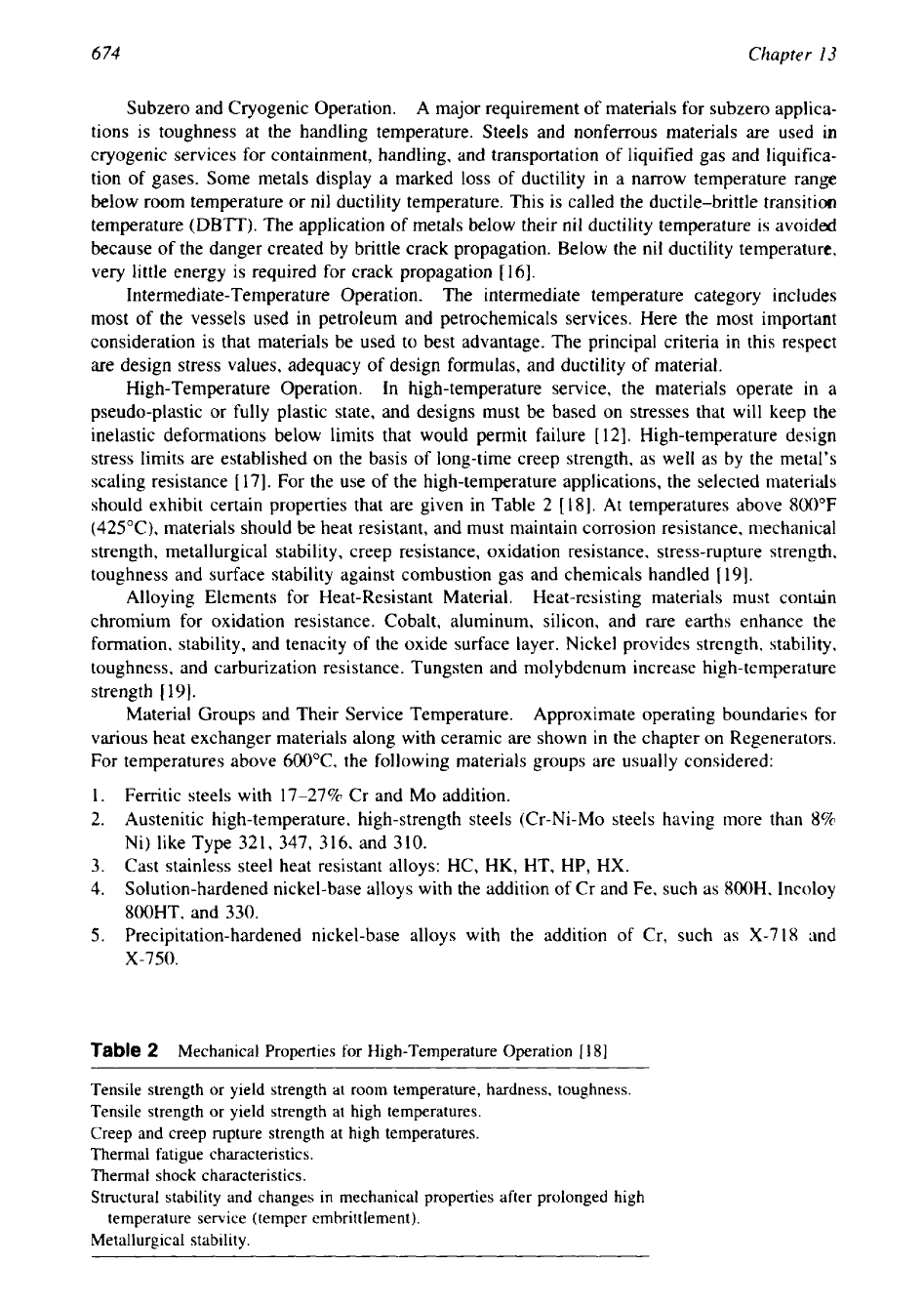
674
Chapter
13
Subzero and Cryogenic Operation.
A major requirement of materials for subzero applica-
tions is toughness at the handling temperature. Steels and nonferrous materials are used in
cryogenic services for containment, handling, and transportation of liquified gas and liquifica-
tion
of
gases. Some metals display a marked loss of ductility in a narrow temperature range
below room temperature or nil ductility temperature. This is called the ductile-brittle transition
temperature
(DBTT).
The application
of
metals below their nil ductility temperature is avoided
because of the danger created by brittle crack propagation. Below the nil ductility temperature,
very little energy is required for crack propagation [16].
Intermediate-Temperature Operation.
The intermediate temperature category includes
most of the vessels used in petroleum and petrochemicals services. Here the most important
consideration is that materials be used to best advantage. The principal criteria in this respect
are design stress values, adequacy of design formulas, and ductility
of
material.
High-Temperature Operation.
In high-temperature service, the materials operate
in
a
pseudo-plastic or
fully
plastic state, and designs must be based on stresses that will keep the
inelastic deformations below limits that would permit failure
[
121. High-temperature design
stress limits are established on the basis of long-time creep strength, as well as by the metal's
scaling resistance
[
171. For the use of the high-temperature applications, the selected materials
should exhibit certain properties that are given in Table 2
[
181. At temperatures above 800°F
(425"C), materials should be heat resistant, and must maintain corrosion resistance, mechanical
strength, metallurgical stability, creep resistance, oxidation resistance, stress-rupture strength,
toughness and surface stability against combustion gas and chemicals handled
[
191.
Alloying Elements for Heat-Resistant Material.
Heat-resisting materials must contain
chromium for oxidation resistance. Cobalt, aluminum, silicon, and rare earths enhance the
formation, stability, and tenacity of the oxide surface layer. Nickel provides strength, stability,
toughness, and carburization resistance. Tungsten and molybdenum increase high-temperature
strength
[
191.
Material Groups and Their Service Temperature.
Approximate operating boundaries for
various heat exchanger materials along with ceramic are shown
in
the chapter on Regenerators.
For temperatures above
600°C
the following materials groups are usually considered:
1.
Ferritic steels with 17-27% Cr and
MO
addition.
2.
Austenitic high-temperature, high-strength steels (Cr-Ni-Mo steels having more than
8%
Ni) like Type 321, 347, 316, and
310.
3.
Cast stainless steel heat resistant alloys: HC, HK, HT, HP, HX.
4.
Solution-hardened nickel-base alloys with the addition of Cr and Fe, such as SOOH, Incoloy
800HT, and 330.
5.
Precipitation-hardened nickel-base alloys with the addition of Cr, such as X-718 and
X-750.
Table
2
Mechanical Properties for High-Temperature Operation
[
181
Tensile strength or
yield
strength
at
room
temperature,
hardness,
toughness.
Tensile
strength
or
yield
strength
at
high
temperatures.
Creep
and
creep
rupture
strength
at
high
temperatures.
Thermal
fatigue
characteristics.
Thermal shock characteristics.
Structural
stability
and
changes
in
mechanical
properties
after
prolonged
high
temperature
service
(temper
embrittlement).
Metallurgical
stability.
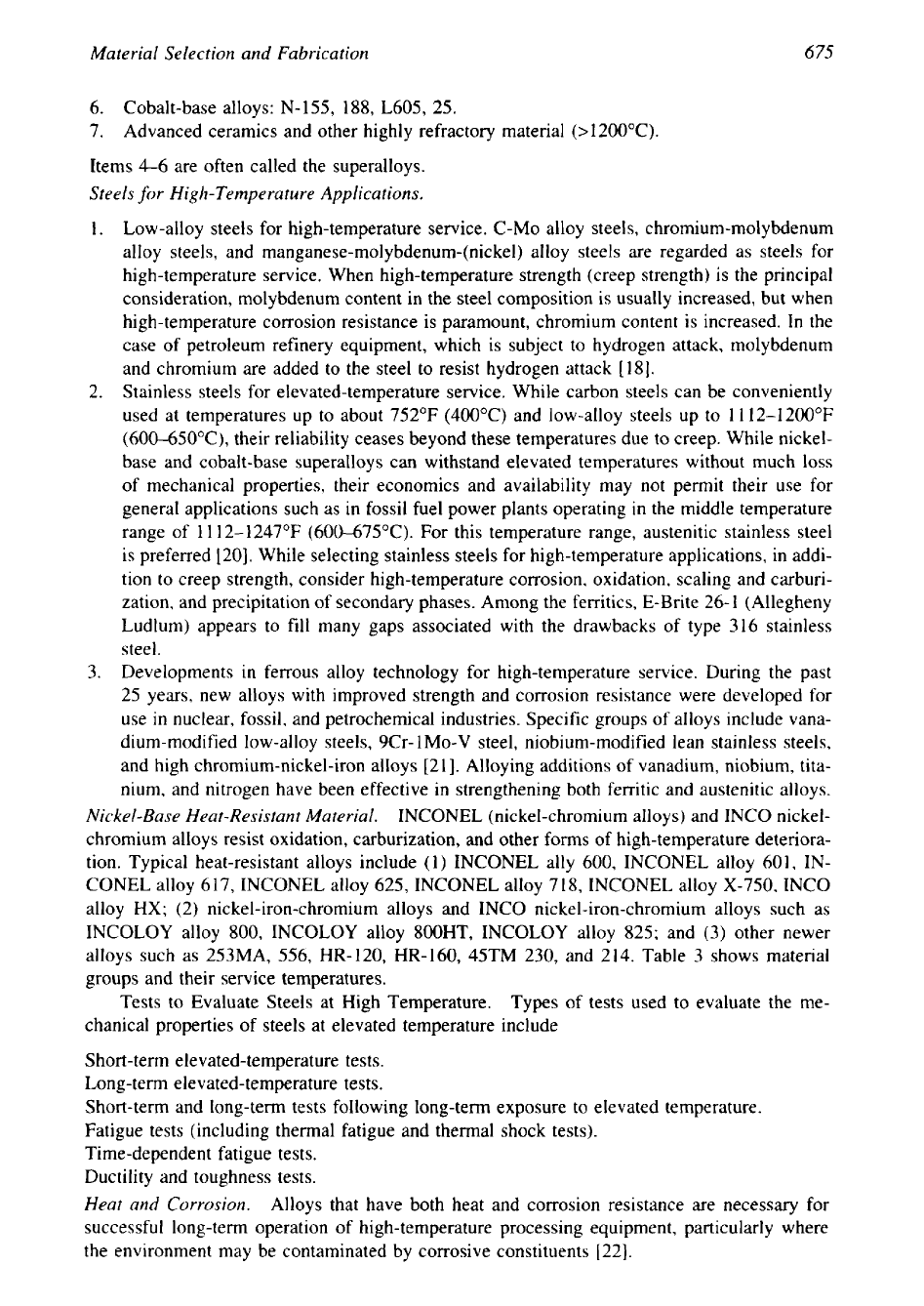
675
Material Selection and Fabrication
6. Cobalt-base alloys: N-155, 188, L605, 25.
7. Advanced ceramics and other highly refractory material
(>
1200°C).
Items 4-6 are often called the superalloys.
Steels
for
High-Temperature Applications.
1.
Low-alloy steels for high-temperature service. C-MO alloy steels, chromium-molybdenum
alloy steels, and manganese-molybdenum-(nickel) alloy steels are regarded as steels for
high-temperature service. When high-temperature strength (creep strength) is the principal
consideration, molybdenum content in the steel composition is usually increased, but when
high-temperature corrosion resistance is paramount, chromium content is increased. In the
case of petroleum refinery equipment, which is subject to hydrogen attack, molybdenum
and chromium are added to the steel to resist hydrogen attack
[
181.
2.
Stainless steels for elevated-temperature service. While carbon steels can be conveniently
used at temperatures up to about 752°F (400°C) and low-alloy steels up to
11
12-1200°F
(6O0-65O0C), their reliability ceases beyond these temperatures due to creep. While nickel-
base and cobalt-base superalloys can withstand elevated temperatures without much loss
of mechanical properties, their economics and availability may not permit their use for
general applications such as in fossil fuel power plants operating
in
the middle temperature
range of 11 12-1247°F (600475°C). For this temperature range, austenitic stainless steel
is preferred [20]. While selecting stainless steels for high-temperature applications, in addi-
tion to creep strength, consider high-temperature corrosion, oxidation, scaling and carburi-
zation, and precipitation of secondary phases. Among the ferritics, E-Brite
26-
1
(Allegheny
Ludlum) appears to fill many gaps associated with the drawbacks of type
316
stainless
steel.
3.
Developments in ferrous alloy technology for high-temperature service. During the past
25 years, new alloys with improved strength and corrosion resistance were developed for
use in nuclear, fossil, and petrochemical industries. Specific groups of alloys include vana-
dium-modified low-alloy steels, 9Cr- 1
MO-V
steel, niobium-modified lean stainless steels,
and high chromium-nickel-iron alloys [2 I]. Alloying additions of vanadium, niobium, tita-
nium, and nitrogen have been effective in strengthening both ferritic and austenitic alloys.
Nickel-Base Heat-Resistant Material.
INCONEL (nickel-chromium alloys) and INCO nickel-
chromium alloys resist oxidation, carburization, and other forms of high-temperature deteriora-
tion. Typical heat-resistant alloys include (1) INCONEL ally
600,
INCONEL alloy 601, IN-
CONEL alloy 617, INCONEL alloy 625, INCONEL alloy 718, INCONEL alloy
X-750,
INCO
alloy
HX;
(2) nickel-iron-chromium alloys and INCO nickel-iron-chromium alloys such as
INCOLOY alloy
800,
INCOLOY alloy 800HT, INCOLOY alloy 825; and
(3)
other newer
alloys such as
253MA,
556,
HR-120, HR-160, 45TM 230, and 214. Table
3
shows material
groups and their service temperatures.
Tests to Evaluate Steels at High Temperature. Types of tests used to evaluate the me-
chanical properties of steels at elevated temperature include
Short-term elevated-temperature tests.
Long-term elevated-temperature tests.
Short-term and long-term tests following long-term exposure to elevated temperature.
Fatigue tests (including thermal fatigue and thermal shock tests).
Time-dependent fatigue tests.
Ductility and toughness tests.
Heat
and
Corrosion.
Alloys that have both heat and corrosion resistance are necessary for
successful long-term operation of high-temperature processing equipment, particularly where
the environment may be contaminated by corrosive constituents [22].
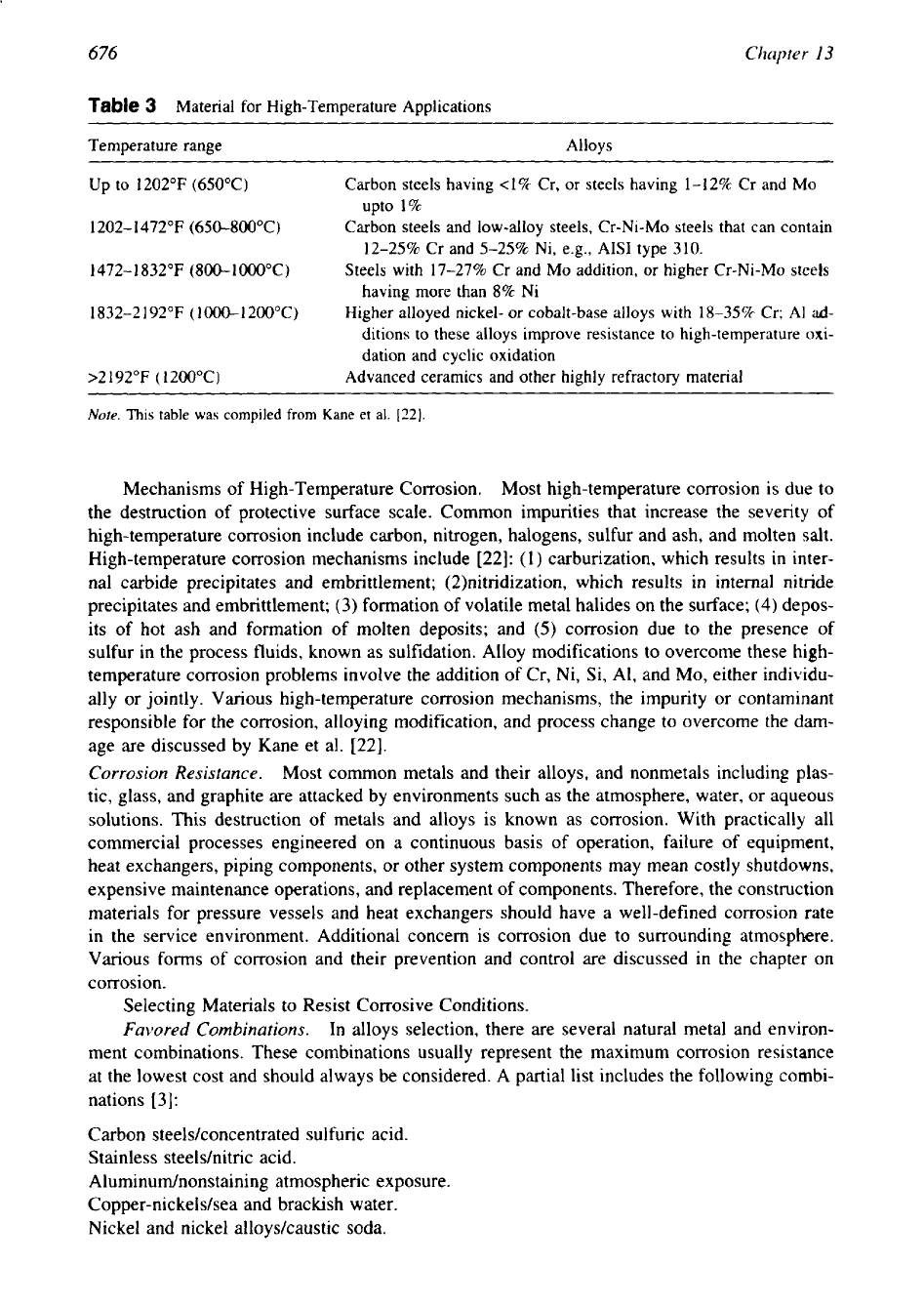
676
Chapter
I3
Table
3
Material for High-Temperature Applications
Temperature range Alloys
Up to 1202°F (650°C)
Carbon steels having
~1%
Cr, or steels having 1-12% Cr and
MO
upto 1%
1202-1472"F(650-800"C)
Carbon steels and low-alloy steels, Cr-Ni-Mo steels that can contain
12-25% Cr and 5-25% Ni,
e.g.,
AISI type 310.
1472-1832"F(800-1000"C)
Steels with 17-27% Cr and MO addition,
or
higher Cr-Ni-Mo steels
having more than
8%
Ni
1832-2192°F (1OOO-1200°C)
Higher alloyed nickel- or cobalt-base alloys with 18-35% Cr; AI
ad-
ditions to these alloys improve resistance to high-temperature oxi-
dation and cyclic oxidation
>2 192°F
(
1200°C)
Advanced ceramics and other highly refractory material
Note.
This
table was compiled from Kane et al.
[22).
Mechanisms of High-Temperature Corrosion.
Most high-temperature corrosion is due to
the destruction
of
protective surface scale. Common impurities that increase the severity
of
high-temperature corrosion include carbon, nitrogen, halogens, sulfur and ash, and molten salt.
High-temperature corrosion mechanisms include [22]:
(1)
carburization, which results in inter-
nal carbide precipitates and embrittlement; (2)nitridization, which results in internal nitride
precipitates and embrittlement;
(3)
formation of volatile metal halides on the surface;
(4)
depos-
its of hot ash and formation of molten deposits; and
(5)
corrosion due to the presence of
sulfur in the process fluids, known as sulfidation. Alloy modifications to overcome these high-
temperature corrosion problems involve the addition
of
Cr, Ni, Si, Al, and MO, either individu-
ally or jointly. Various high-temperature corrosion mechanisms, the impurity or contaminant
responsible for the corrosion, alloying modification, and process change to overcome the dam-
age are discussed by Kane et al.
[22].
Corrosion
Resistance.
Most common metals and their alloys, and nonmetals including plas-
tic, glass, and graphite are attacked by environments such as the atmosphere, water, or aqueous
solutions. This destruction of metals and alloys is known as corrosion. With practically all
commercial processes engineered on a continuous basis of operation, failure of equipment,
heat exchangers, piping components, or other system components may mean costly shutdowns,
expensive maintenance operations, and replacement
of
components. Therefore, the construction
materials for pressure vessels and heat exchangers should have a well-defined corrosion rate
in the service environment. Additional concern is corrosion due to surrounding atmosphere.
Various forms
of
corrosion and their prevention and control are discussed in the chapter on
corrosion.
Selecting Materials to Resist Corrosive Conditions.
Fuvored
Combinations.
In alloys selection, there are several natural metal and environ-
ment combinations. These combinations usually represent the maximum corrosion resistance
at the lowest cost and should always be considered. A partial list includes the following combi-
nations
[3]:
Carbon steelskoncentrated sulfuric acid.
Stainless steeldnitric acid.
Aluminumhonstaining atmospheric exposure.
Copper-nickels/sea and brackish water.
Nickel and nickel alloyskaustic soda.
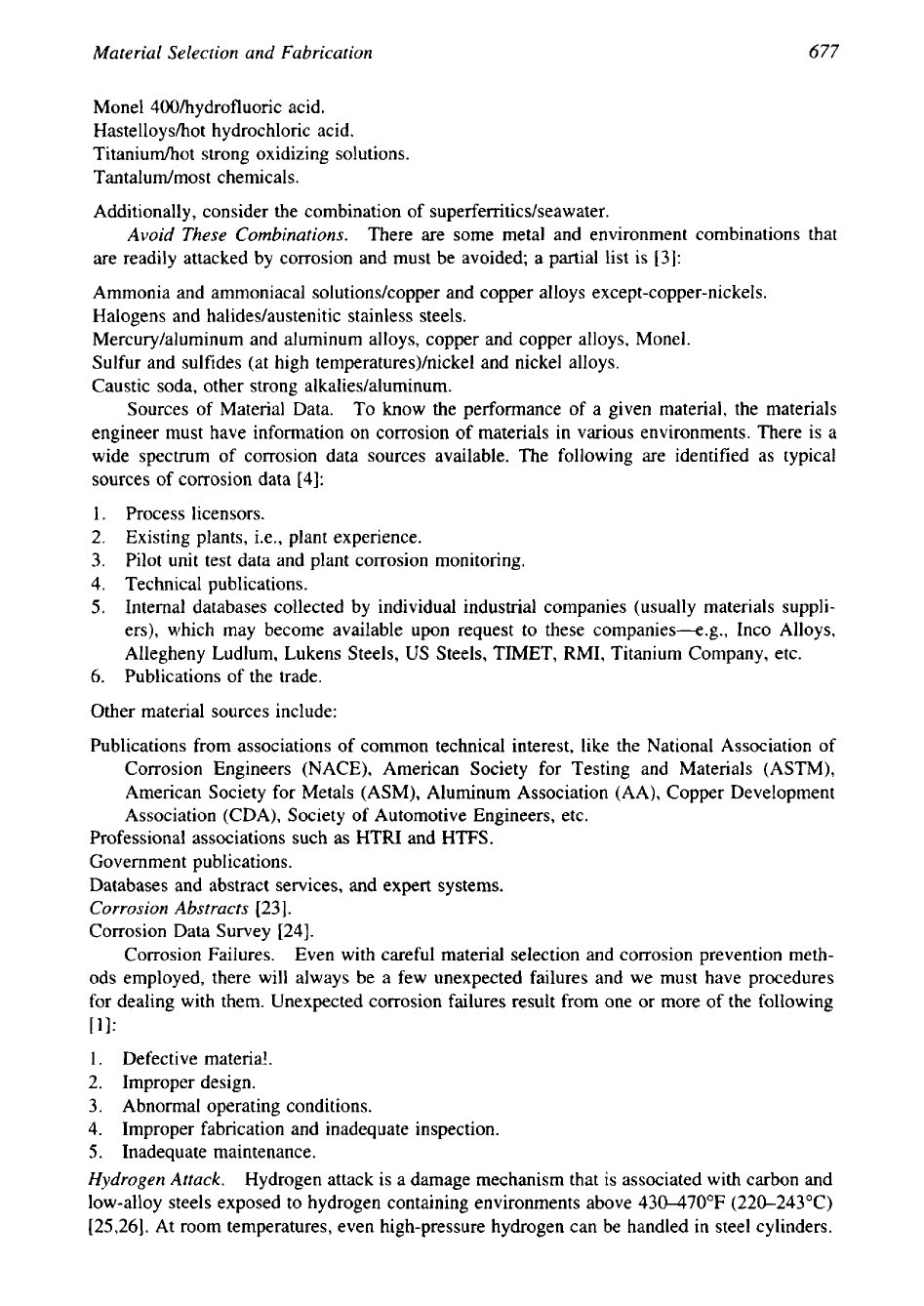
677
Material Selection and Fabrication
Monel 400hydrofluoric acid.
Hastelloyshot hydrochloric acid.
Titaniudot strong oxidizing solutions.
Tan taludmos t chemicals.
Additionally, consider the combination of
superferritics/seawater.
Avoid These Combinations.
There are some metal and environment combinations that
are readily attacked by corrosion and must be avoided; a partial list is [3]:
Ammonia and ammoniacal solutionskopper and copper alloys except-copper-nickels.
Halogens and halides/austenitic stainless steels.
Mercury/aluminum and aluminum alloys, copper and copper alloys, Monel.
Sulfur and sulfides (at high temperatures)/nickel and nickel alloys.
Caustic soda, other strong alkalies/aluminum.
Sources of Material Data. To
know
the performance of a given material, the materials
engineer must have information on corrosion of materials in various environments. There is a
wide spectrum of corrosion data sources available. The following are identified as typical
sources
of
corrosion data [4]:
1.
Process licensors.
2.
Existing plants, i.e., plant experience.
3.
Pilot unit test data and plant corrosion monitoring.
4.
Technical publications.
5.
Internal databases collected by individual industrial companies (usually materials suppli-
ers), which may become available upon request to these companies-ag., Inco Alloys,
Allegheny Ludlum, Lukens Steels, US Steels, TIMET, RMI, Titanium Company, etc.
6. Publications of the trade.
Other material sources include:
Publications from associations of common technical interest, like the National Association of
Corrosion Engineers (NACE), American Society for Testing and Materials (ASTM),
American Society for Metals (ASM), Aluminum Association (AA), Copper Development
Association (CDA), Society of Automotive Engineers, etc.
Professional associations such as HTRI and
HTFS.
Government publications.
Databases and abstract services, and expert systems.
Corrosion Abstracts
[23].
Corrosion Data Survey [24].
Corrosion Failures. Even with careful material selection and corrosion prevention meth-
ods employed, there will always be a few unexpected failures and we must have procedures
for dealing with them. Unexpected corrosion failures result from one or more of the following
PI:
1.
Defective material.
2. Improper design.
3.
Abnormal operating conditions.
4.
Improper fabrication and inadequate inspection.
5.
Inadequate maintenance.
Hydrogen Attack.
Hydrogen attack is a damage mechanism that is associated with carbon and
low-alloy steels exposed to hydrogen containing environments above 430470°F (220-243°C)
[25,26]. At room temperatures, even high-pressure hydrogen can be handled in steel cylinders.
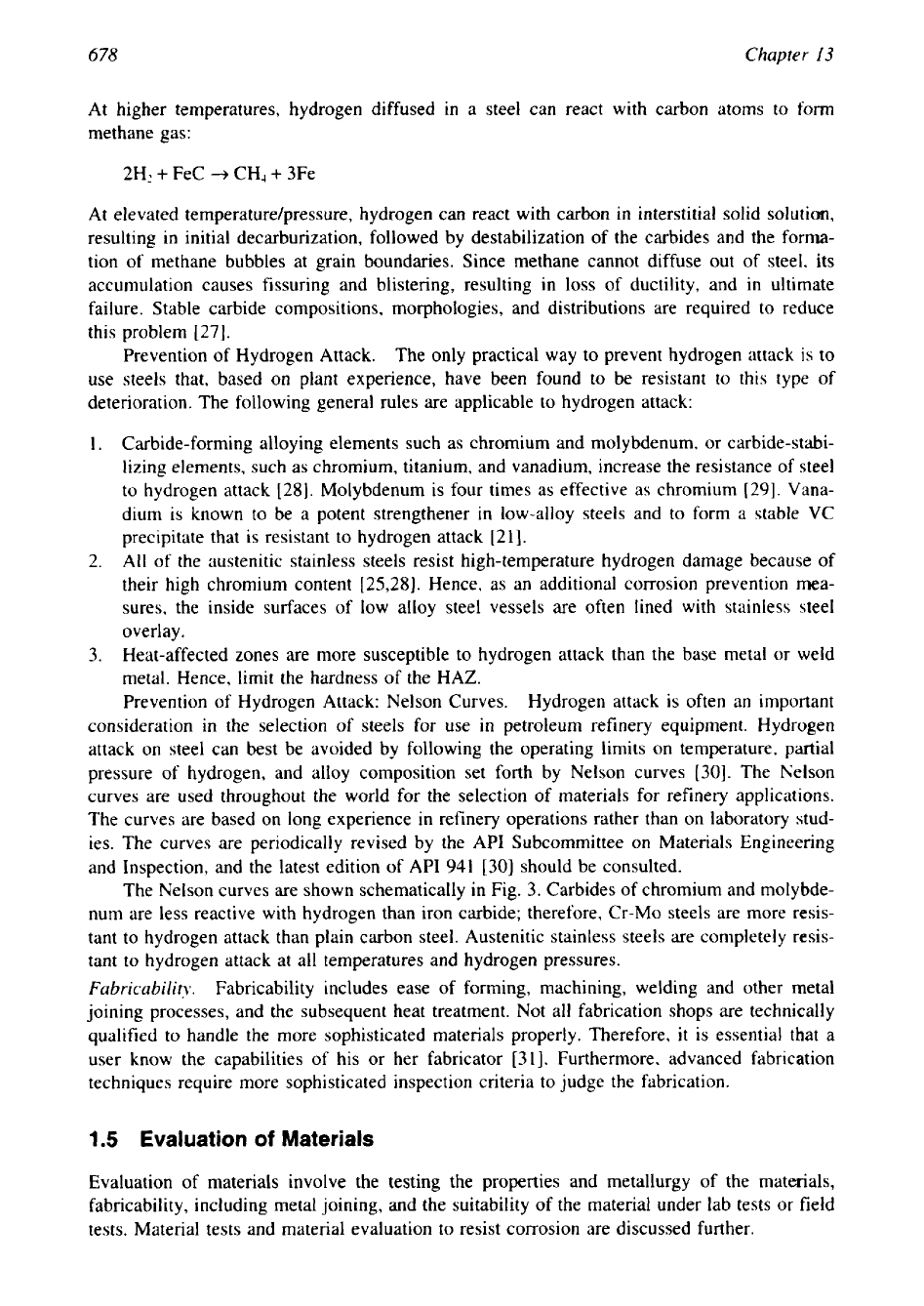
678
Chapter
I3
At higher temperatures, hydrogen diffused in a steel can react with carbon atoms to form
methane gas:
2H2
+
FeC
-+
CH4
+
3Fe
At elevated temperature/pressure, hydrogen can react with carbon in interstitial solid solutian,
resulting in initial decarburization, followed by destabilization of the carbides and the forma-
tion of methane bubbles at grain boundaries. Since methane cannot diffuse out of steel, its
accumulation causes fissuring and blistering, resulting in loss of ductility, and in ultimate
failure. Stable carbide compositions, morphologies, and distributions are required to reduce
this problem [27].
Prevention of Hydrogen Attack.
The only practical way to prevent hydrogen attack is to
use steels that, based on plant experience, have been found to be resistant to this type of
deterioration. The following general rules are applicable to hydrogen attack:
1.
Carbide-forming alloying elements such as chromium and molybdenum, or carbide-stabi-
lizing elements, such as chromium, titanium, and vanadium, increase the resistance of steel
to hydrogen attack [28]. Molybdenum is four times as effective as chromium
(291.
Vana-
dium is known to be a potent strengthener
in
low-alloy steels and to form a stable
VC
precipitate that is resistant to hydrogen attack [21].
2.
All
of the austenitic stainless steels resist high-temperature hydrogen damage because of
their high chromium content 125,281. Hence, as an additional corrosion prevention
mea-
sures, the inside surfaces of low alloy steel vessels are often lined with stainless steel
overlay.
3.
Heat-affected zones are more susceptible to hydrogen attack than the base metal or weld
metal. Hence, limit the hardness
of
the HAZ.
Prevention of Hydrogen Attack: Nelson Curves. Hydrogen attack is often an important
consideration
in
the selection of steels for use
in
petroleum refinery equipment. Hydrogen
attack on steel can best be avoided by following the operating limits on temperature, partial
pressure of hydrogen, and alloy composition set forth by Nelson curves
[30].
The Nelson
curves are used throughout the world for the selection of materials for refinery applications.
The curves are based on long experience in refinery operations rather than on laboratory stud-
ies. The curves are periodically revised by the API Subcommittee on Materials Engineering
and Inspection, and the latest edition of API
941
[30] should be consulted.
The Nelson curves are shown schematically in Fig. 3. Carbides of chromium and molybde-
num are less reactive with hydrogen than iron carbide; therefore, Cr-Mo steels are more resis-
tant to hydrogen attack than plain carbon steel. Austenitic stainless steels are completely resis-
tant to hydrogen attack at all temperatures and hydrogen pressures.
Fabricability
.
Fabricability includes ease
of
forming, machining, welding and other metal
joining processes, and the subsequent heat treatment. Not all fabrication shops are technically
qualified to handle the more sophisticated materials properly. Therefore, it is essential that a
user know the capabilities
of
his or her fabricator [3
I].
Furthermore, advanced fabrication
techniques require more sophisticated inspection criteria to judge the fabrication.
1.5
Evaluation
of
Materials
Evaluation of materials involve the testing the properties and metallurgy of the materials,
fabricability, including metal joining, and the suitability
of
the material under lab tests or field
tests. Material tests and material evaluation to resist corrosion are discussed further.
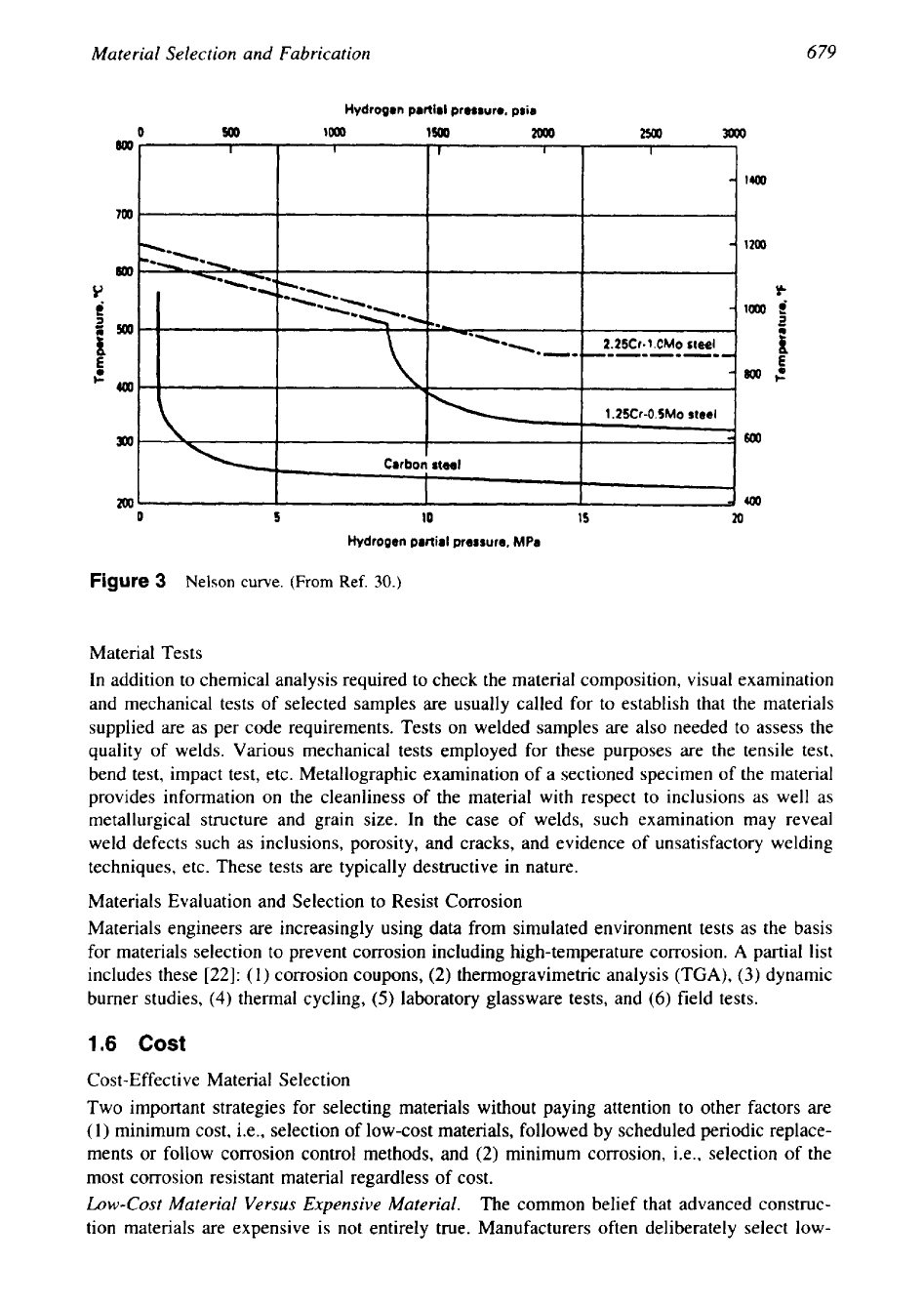
679
Material Selection and Fabrication
0
Y
f
-500
k
E
f,
0
5
10
15
Hydrogen partial pressure,
MPa
Figure
3
Nelson
curve.
(From Ref.
30.)
Material Tests
In addition to chemical analysis required to check the material composition, visual examination
and mechanical tests of selected samples are usually called for to establish that the materials
supplied are as per code requirements. Tests on welded samples are also needed to assess the
quality of welds. Various mechanical tests employed for these purposes are the tensile test,
bend test, impact test, etc. Metallographic examination of a sectioned specimen of the material
provides information on the cleanliness of the material with respect to inclusions as well as
metallurgical structure and grain size. In the case of welds, such examination may reveal
weld defects such as inclusions, porosity, and cracks, and evidence of unsatisfactory welding
techniques, etc. These tests are typically destructive in nature.
Materials Evaluation and Selection to Resist Corrosion
Materials engineers are increasingly using data from simulated environment tests as the basis
for materials selection to prevent corrosion including high-temperature corrosion.
A
partial list
includes these
[22]:
(
1)
corrosion coupons,
(2)
thermogravimetric analysis
(TGA),
(3)
dynamic
burner studies,
(4)
thermal cycling,
(5)
laboratory glassware tests, and
(6)
field tests.
1.6
Cost
Cost-Effective Material Selection
Two important strategies for selecting materials without paying attention to other factors are
(1)
minimum cost, i.e., selection of low-cost materials, followed by scheduled periodic replace-
ments or follow corrosion control methods, and
(2)
minimum corrosion, i.e., selection of the
most corrosion resistant material regardless of cost.
Low-Cost Material Versus Expensive Material.
The common belief that advanced construc-
tion materials are expensive is not entirely true. Manufacturers often deliberately select low-
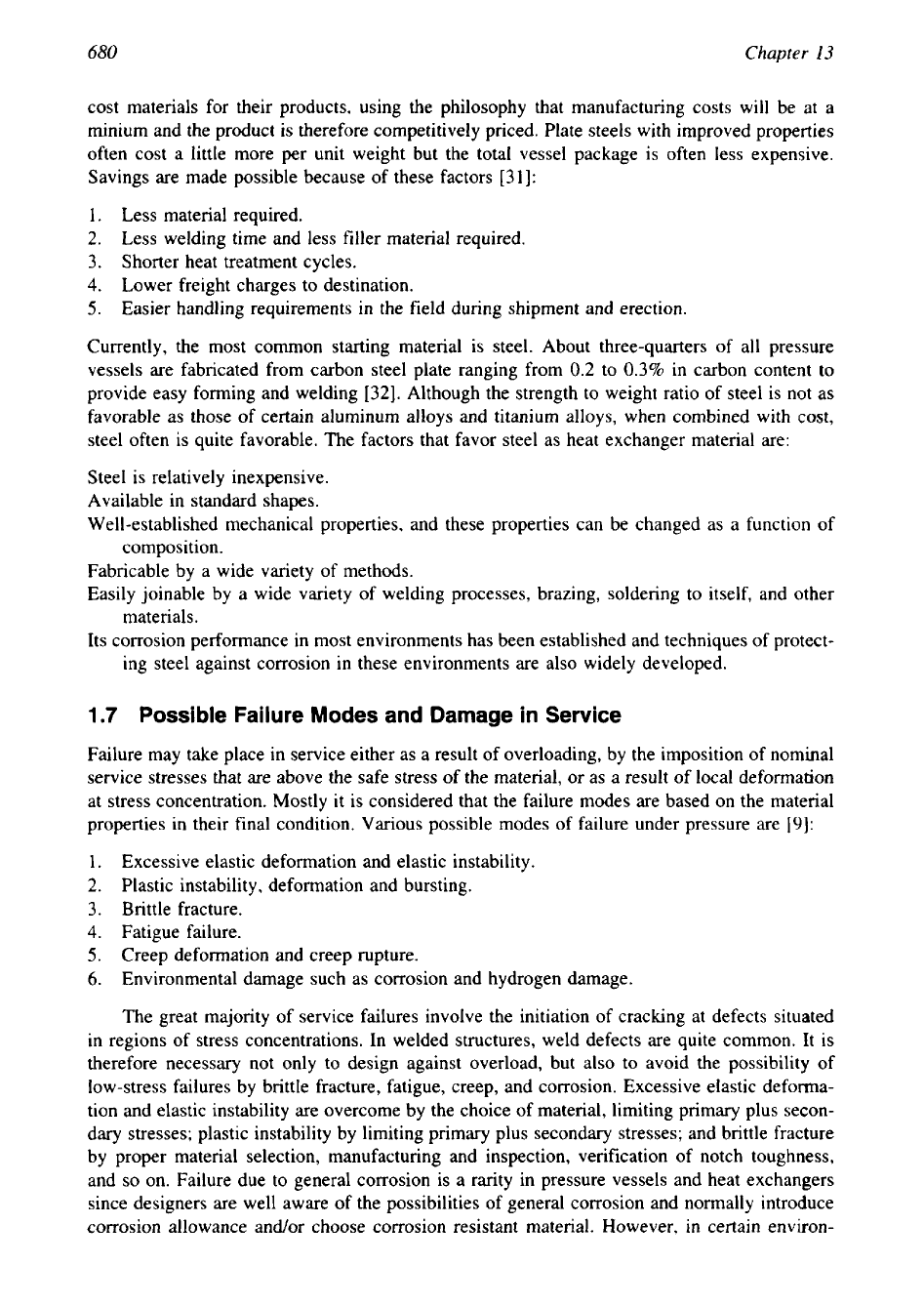
680
Chapter
13
cost materials for their products, using the philosophy that manufacturing costs will be at a
minium and the product is therefore competitively priced. Plate steels with improved properties
often cost a little more per unit weight but the total vessel package is often less expensive.
Savings are made possible because of these factors
[31]:
1. Less material required.
2.
Less welding time and less filler material required.
3.
Shorter heat treatment cycles.
4.
Lower freight charges to destination.
5.
Easier handling requirements in the field during shipment and erection.
Currently, the most common starting material is steel. About three-quarters of all pressure
vessels are fabricated from carbon steel plate ranging from
0.2
to
0.3%
in carbon content to
provide easy forming and welding
[32].
Although the strength to weight ratio of steel is not as
favorable as those
of
certain aluminum alloys and titanium alloys, when combined with cost,
steel often is quite favorable. The factors that favor steel as heat exchanger material are:
Steel is relatively inexpensive.
Available in standard shapes.
Well-established mechanical properties, and these properties can be changed as a function of
composition.
Fabricable by a wide variety of methods.
Easily joinable by a wide variety of welding processes, brazing, soldering to itself, and other
materials.
Its corrosion performance in most environments has been established and techniques of protect-
ing steel against corrosion in these environments are also widely developed.
1.7
Possible Failure Modes and Damage in Service
Failure may take place in service either as a result of overloading, by the imposition
of
nominal
service stresses that are above the safe stress of the material, or as a result of local deformation
at stress concentration. Mostly it is considered that the failure modes are based on the material
properties in their final condition. Various possible modes of failure under pressure are
191:
1.
Excessive elastic deformation and elastic instability.
2.
Plastic instability, deformation and bursting.
3.
Brittle fracture.
4.
Fatigue failure.
5.
Creep deformation and creep rupture.
6.
Environmental damage such as corrosion and hydrogen damage.
The great majority of service failures involve the initiation of cracking at defects situated
in regions of stress concentrations. In welded structures, weld defects are quite common. It is
therefore necessary not only to design against overload, but also to avoid the possibility of
low-stress failures by brittle fracture, fatigue, creep, and corrosion. Excessive elastic deforma-
tion and elastic instability are overcome by the choice
of
material, limiting primary plus secon-
dary stresses; plastic instability by limiting primary plus secondary stresses; and brittle fracture
by proper material selection, manufacturing and inspection, verification of notch toughness,
and
so
on. Failure due to general corrosion is a rarity in pressure vessels and heat exchangers
since designers are well aware of the possibilities
of
general corrosion and normally introduce
corrosion allowance andor choose corrosion resistant material. However, in certain environ-
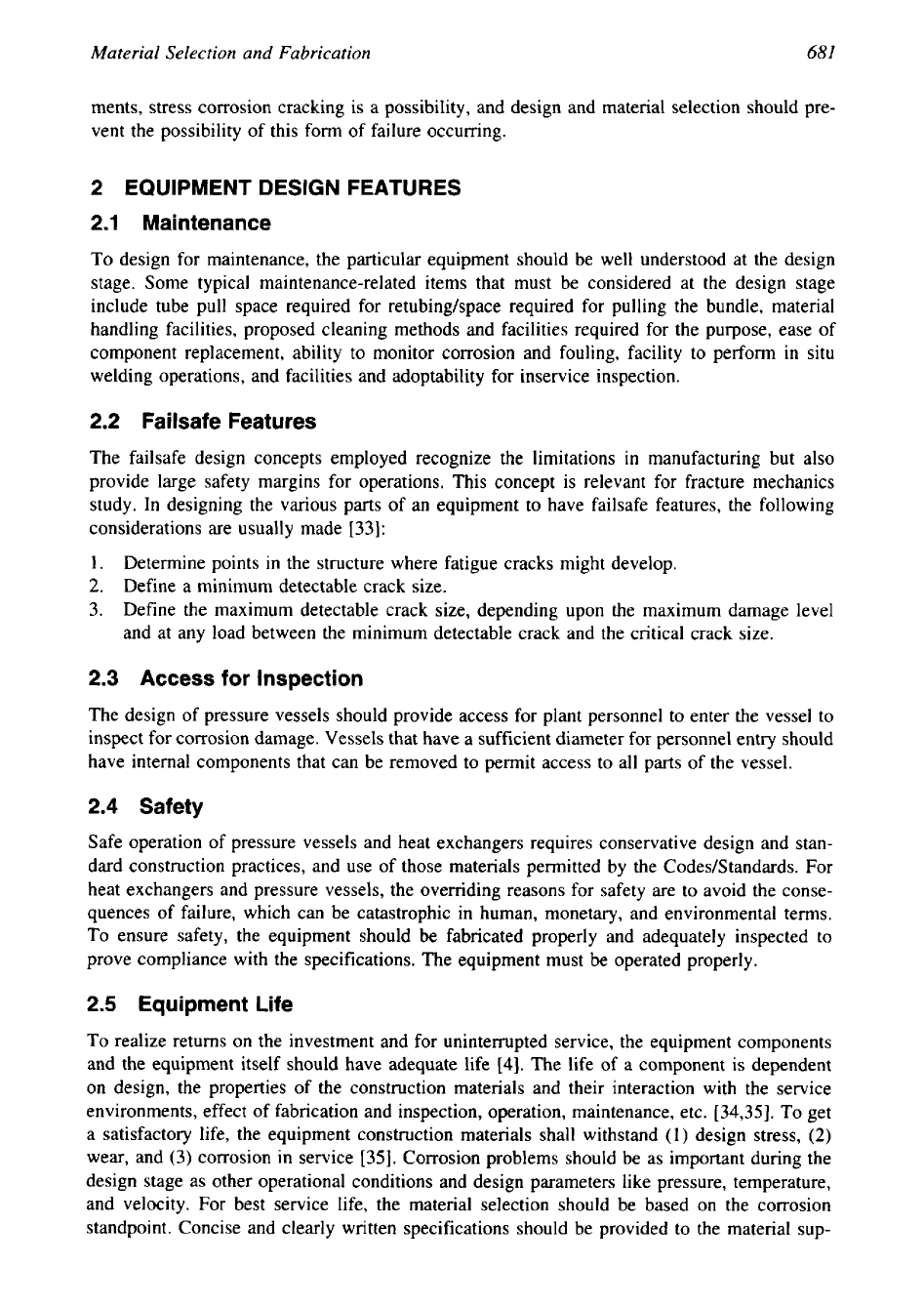
Material Selection and Fabrication
681
ments, stress corrosion cracking is a possibility, and design and material selection should pre-
vent the possibility of this form of failure occurring.
2
EQUIPMENT DESIGN FEATURES
2.1
Maintenance
To design for maintenance, the particular equipment should be well understood at the design
stage. Some typical maintenance-related items that must be considered at the design stage
include tube pull space required for retubingkpace required for pulling the bundle, material
handling facilities, proposed cleaning methods and facilities required for the purpose, ease of
component replacement, ability to monitor corrosion and fouling, facility to perform in situ
welding operations, and facilities and adoptability for inservice inspection.
2.2
Failsafe Features
The failsafe design concepts employed recognize the limitations in manufacturing but also
provide large safety margins for operations. This concept is relevant for fracture mechanics
study. In designing the various parts of an equipment to have failsafe features, the following
considerations are usually made
[33]:
1.
Determine points in the structure where fatigue cracks might develop.
2.
Define a minimum detectable crack size.
3.
Define the maximum detectable crack size, depending upon the maximum damage level
and at any load between the minimum detectable crack and the critical crack size.
2.3
Access for Inspection
The design of pressure vessels should provide access for plant personnel to enter the vessel to
inspect for corrosion damage. Vessels that have a sufficient diameter for personnel entry should
have internal components that can be removed to permit access to all parts of the vessel.
2.4
Safety
Safe operation of pressure vessels and heat exchangers requires conservative design and stan-
dard construction practices, and use of those materials permitted by the Codes/Standards. For
heat exchangers and pressure vessels, the overriding reasons for safety are to avoid the conse-
quences of failure, which can be catastrophic in human, monetary, and environmental terms.
To
ensure safety, the equipment should
be
fabricated properly and adequately inspected to
prove compliance with the specifications. The equipment must be operated properly.
2.5
Equipment Life
To realize returns on the investment and for uninterrupted service, the equipment components
and the equipment itself should have adequate life
[4].
The life
of
a component is dependent
on design, the properties of the construction materials and their interaction with the service
environments, effect of fabrication and inspection, operation, maintenance, etc.
[34,35].
To get
a satisfactory life, the equipment construction materials shall withstand
(1)
design stress,
(2)
wear, and
(3)
corrosion in service
[35].
Corrosion problems should be as important during the
design stage as other operational conditions and design parameters like pressure, temperature,
and velocity. For best service life, the material selection should be based on the corrosion
standpoint. Concise and clearly written specifications should be provided to the material sup-

682
Chapter
13
plier to ensure the proper material supply. The design details should preserve the built-in
corrosion resistance of the materials.
Component Life
Exchanger shells, channels, and tubesheets should be designed for a minimum of
10
years or
the original tube bundle life plus two additional retubings. The initial tubes should be chosen
for a minimum
of
two run lengths or
5
years unless spare exchangers are provided, in which
case a shorter expected life may be attractive
[4].
However, this may not be relevant for nuclear
heat exchangers and pressure vessels.
2.6
Field Trials
A
number of accelerated tests are used to build and to increase confidence in heat exchanger
design, particularly, radiator design, before large-scale fleet trials. Some
of
these tests were
designed to represent worst field conditions and were later correlated with field service returns.
These tests are primarily used to assess the mechanical durability and the internal and external
corrosion resistance
of
aluminum radiators. This aspect is further discussed
in
detail
in
the
chapter on brazing.
3
RAW MATERIAL FORMS USED IN THE CONSTRUCTION
OF
HEAT EXCHANGERS
In the construction of heat exchangers, various forms of raw materials are used. The raw
material forms include plates, sheets and strips, pipes and tubes, forgings, castings, bars and
rods, etc. Major use for sheets and strips are in the construction of compact heat exchangers
and plate heat exchangers. Tubes are used both in compact heat exchangers and shell-and-tube
heat exchangers. The other forms are used extensively in the fabrication
of
shell-and-tube heat
exchangers.
In this section, various raw material product forms are discussed with specific reference
to ASTM specifications
[36].
As far as the plates and tubes are concerned, plate steels and
ferrous tubings are discussed here. Nonferrous plates and tubes are covered in their respective
sections.
3.1
Castings
Castings may be used in the construction of pressure vessels and vessel parts. Cast heads are
used for feed water heaters. Codes restrict maximum allowable stress values for acceptable
casting materials. These allowable stress values should be multiplied by the applicable casting
quality factor for all materials except cast iron.
3.2
Forgings
Forged materials may be used in pressure-vessel and heat-exchanger construction provided the
materials have been worked sufficiently to remove the coarse ingot structure. Tubesheets, chan-
nel covers, blind flange covers, etc., when made from forgings should
be
supplied as proof
machined forgings. All further machine operations, drilling, etc. should be done by the fabrica-
tor. Before machining, the forging is to be examined ultrasonically. Most of the defects in a
forging are caused by conditions produced in the ingot stage, such as segregation, piping or
nonmetallic inclusions, laps or seam due to subsequent hot or cold forging, and excessive scale
leading to surface flaws, etc. For this reason, the acceptance standard for a forging is usually
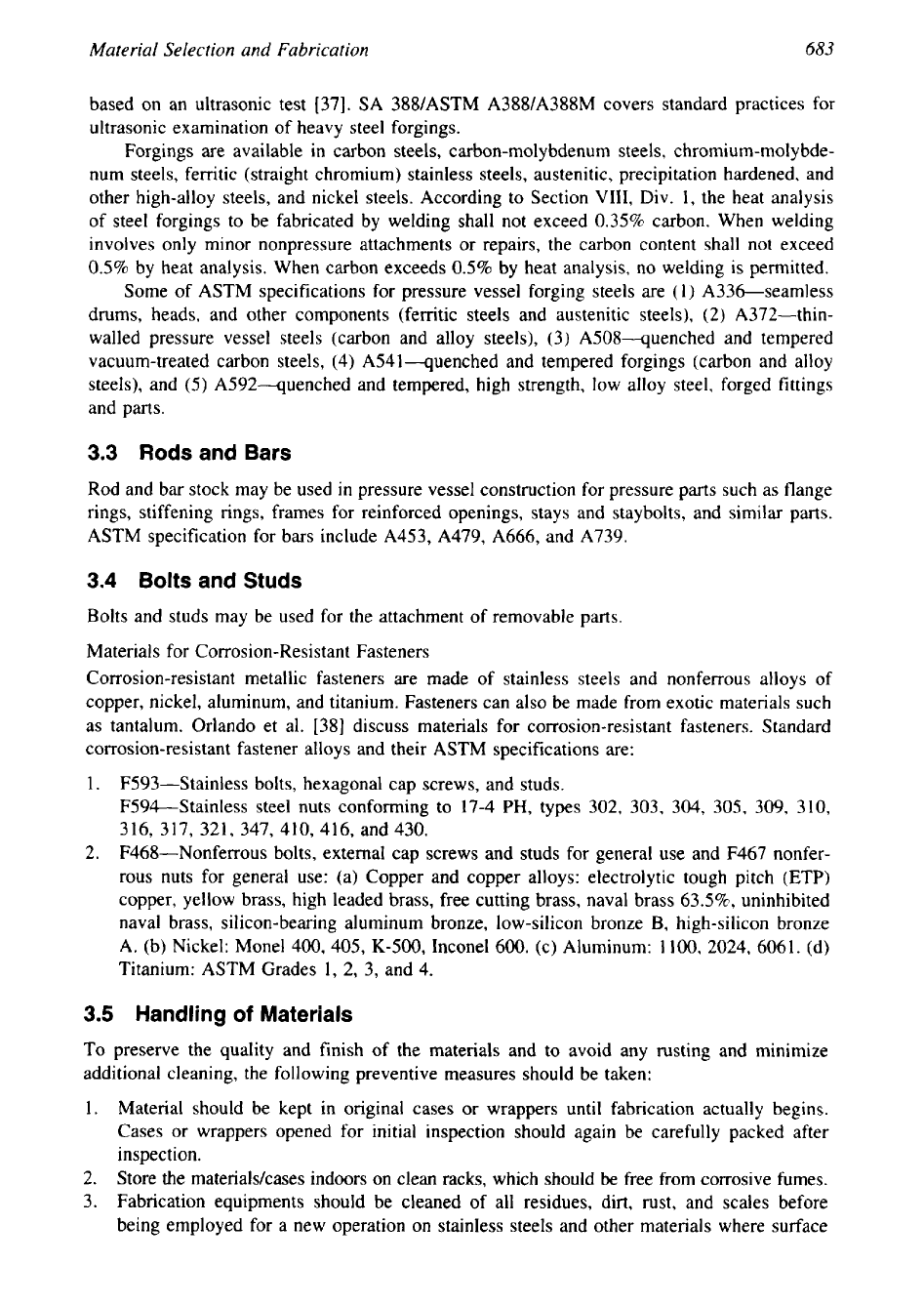
Material Selection and Fabrication
683
based on an ultrasonic test [37]. SA 388/ASTM A388/A388M covers standard practices for
ultrasonic examination of heavy steel forgings.
Forgings are available in carbon steels, carbon-molybdenum steels, chromium-molybde-
num steels, ferritic (straight chromium) stainless steels, austenitic, precipitation hardened, and
other high-alloy steels, and nickel steels. According to Section
VIII,
Div.
I,
the heat analysis
of steel forgings to be fabricated by welding shall not exceed 0.35% carbon. When welding
involves only minor nonpressure attachments or repairs, the carbon content shall not exceed
0.5%
by heat analysis. When carbon exceeds
0.5%
by heat analysis, no welding is permitted.
Some of ASTM specifications for pressure vessel forging steels are
(1)
A336-seamless
drums, heads, and other components (ferritic steels and austenitic steels), (2) A372-thin-
walled pressure vessel steels (carbon and alloy steels), (3) A508-quenched and tempered
vacuum-treated carbon steels, (4) A54 l-quenched and tempered forgings (carbon and alloy
steels), and
(5)
A592-quenched and tempered, high strength,
low
alloy steel, forged fittings
and parts.
3.3
Rods
and Bars
Rod and bar stock may be used in pressure vessel construction for pressure parts such as flange
rings, stiffening rings, frames for reinforced openings, stays and staybolts, and similar parts.
ASTM specification for bars include A453, A479, A666, and A739.
3.4
Bolts
and
Studs
Bolts and studs may be used for the attachment of removable parts.
Materials for Corrosion-Resistant Fasteners
Corrosion-resistant metallic fasteners are made of stainless steels and nonferrous alloys of
copper, nickel, aluminum, and titanium. Fasteners can also be made from exotic materials such
as tantalum. Orlando et al. [38] discuss materials for corrosion-resistant fasteners. Standard
corrosion-resistant fastener alloys and their ASTM specifications are:
1.
F593-Stainless bolts, hexagonal cap screws, and studs.
F594-Stainless steel nuts conforming to 17-4
PH,
types 302, 303, 304, 305, 309, 310,
316, 317, 321, 347,410,416, and430.
2.
F468-Nonferrous bolts, external cap screws and studs for general use and F467 nonfer-
rous nuts for general use: (a) Copper and copper alloys: electrolytic tough pitch (ETP)
copper, yellow brass, high leaded brass, free cutting brass, naval brass 63.5%, uninhibited
naval brass, silicon-bearing aluminum bronze, low-silicon bronze B, high-silicon bronze
A. (b) Nickel: Monel 400, 405,
K-500,
Inconel600. (c) Aluminum:
1100,
2024, 6061. (d)
Titanium: ASTM Grades 1, 2,
3,
and 4.
3.5
Handling
of
Materials
To
preserve the quality and finish of the materials and to avoid any rusting and minimize
additional cleaning, the following preventive measures should be taken:
1.
Material should be kept in original cases or wrappers until fabrication actually
begins.
Cases or wrappers opened for initial inspection should again be carefully packed after
inspection.
2.
Store the materialskases indoors on clean racks, which should be free from corrosive fumes.
3.
Fabrication equipments should be cleaned of all residues, dirt, rust, and scales before
being employed for a new operation on stainless steels and other materials where surface
